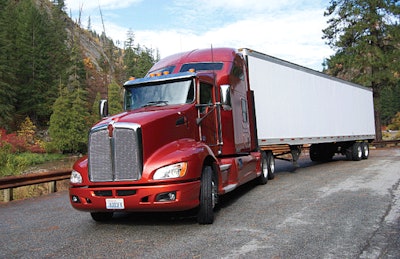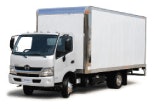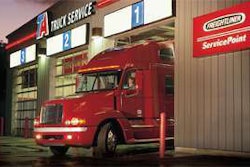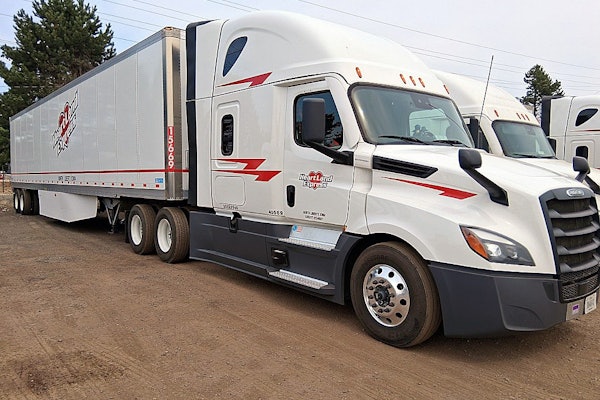Product reviews, OEM & supplier news and equipment management trends
By Jack Roberts
Enduring classic
Kenworth’s T660 evolves with mix of styling, technology
On a recent gray northwestern morning in Seattle, I found myself inching along Interstate 405 at rush hour, the eight-lane bypass basically a parking lot. I was behind the wheel of a new Kenworth T660 Studio AeroCab tractor with an 86-inch sleeper and Diamond VIT interior and a fully-loaded 53-foot van trailer in tow.
 The Kenworth T660 features a compelling blend of conventional styling and aerodynamics aggressive enough to merit SmartWay certification by the U.S. Environmental Protection Agency.
The Kenworth T660 features a compelling blend of conventional styling and aerodynamics aggressive enough to merit SmartWay certification by the U.S. Environmental Protection Agency.The T660’s full suite of driver enhancement aids included a Paccar-branded Eaton UltraShift Plus automated manual transmission, Kenworth NavPlus with true-truck GPS navigation and hands-free phone capability, and Takata’s Lane Departure Warning system. So my situation, in spite of the traffic, was good indeed.
Scan the T660’s cab and sleeper, and you’ll find ultra-luxurious leather, highly effective sound dampening and refinements such as full power options, faux-wooden trim, fully tilting/telescopic steering wheel, skylights and foldable bunk beds, which can be swapped out easily for a single-mattress setup.
The goal on this brisk fall day was to take this 78,000-pound rig over the Cascade Mountains. I was taking U.S. 2 out of Seattle with the goal of lunch in the Bavarian-style village of Leavenworth before heading back for one more round with Seattle traffic. U.S. 2 is a narrow, twisting two-lane road cut through the heart of the mountains, offering stunningly beautiful vistas awash in brilliant fall colors. It climbs steadily from near-sea level to elevations in excess of 4,000 feet near Stevens Pass. It’s tough driving with lots of turnouts.
The tractor has cemented its place in the company’s lineup.
Luckily, my T660 had a brand-new 500-hp Cummins ISX15 under its severely-sloped front hood, which is part of Kenworth’s deluxe aerodynamic enhancement package. Combined with the UltraShift plus AMT, I would have plenty of on-demand power to lug up those long grades. The steering wheel-mounted Cummins engine brake controls, operated by a simple thumb tap, also were handy on the downhill run.
The truck handled great, a definite plus on these twisting roads. I also liked the cab layout; the narrow design gives an impression of being behind the wheel of a much smaller vehicle. Even without the handy optional steering wheel controls, everything was within easy reach. This is due partly to the narrow cab layout, but it’s also a testament to the time and energy Kenworth engineers put into the control layout, instrument cluster and other ergonomic details. Even though this T660 was new, the interior’s tightness still was remarkable; nothing rattles or vibrates. Combined with the ultra-quiet ISX15, it made for remarkably fatigue-free driving.
*Driver enhancement: Kenworth’s full suite of aids help in heavy traffic.
*Plenty of power: Cummins’ ISX15 and Eaton’s UltraShift Plus AMT can handle any hill.
*Lane departure warnings: Takata’s system can be disabled for 10 minutes if needed.
In the morning interstate highway traffic, I was pleased at how well the lane departure warning system worked. A side-mounted camera keeps an eye out for lane markings, and if the picture of the unbroken pavement is interrupted by a painted line, an alarm sounds.
The system was helpful most of the time, but the long afternoon drive on snaky mountain roads, coupled with fatigue from hours of driving, resulted in frequent lane departure alerts. I looked for a way to turn the alarm off, but I eventually gave up.
After the test drive, I spoke with Takata’s Tim Rankin about the warning system’s performance in that driving environment. He assured me the company understands how certain road conditions can turn the system into an unintentional distraction.
To remedy that, the system has a temporary “kill” switch – one I wasn’t aware of during the test drive – that allows the driver to disable it for 10 minutes. Additionally, Rankin said, because there are so many audible and visual distractions in modern truck cabs, Takata is re-evaluating its alarms.
“The consensus is we’ll use a ‘rumble strip’ sound,” he said. “It’s a unique sound that will instantly communicate to the driver what the danger is.”
All told, Kenworth’s T660 ranks among the finest of trucks I’ve tested. The new T680 is getting the lion’s share of the spotlight, and that’s understandable given the time and money the company put into its development. But Kenworth has made it clear that the T660 has a confirmed spot in its model lineup, which reflects the company’s understanding of its customer base: It has a truck for everybody.
2012 Kenworth T660 specs as tested
Engine: Cummins ISX15
Horsepower: 485 @ 1,800 rpm
Torque rating: 1,650 lb.-ft. @ 1,200 rpm
Transmission: Eaton FO16E313A-MHP UltraShift Plus with Hill Start Aid
Gross vehicle weight rating: 53,200 lbs.
Gross axle weight rating, front: 13,200 lbs.
Gross axle weight rating, rear: 20,000 lbs.
Front and rear brakes: Bendix air disc
Rear axle ratio: 3:55
Front tires: Michelin XZA3+ 275/80R22.5 16PR
Rear Tires: Michelin XDA3 275/80R22.5 14PR

JACK ROBERTS is Executive Editor of Commercial Carrier Journal. E-mail [email protected] or call (205) 248-1358.
FCCC delivers 40 hydraulic hybrids to UPS
 UPS will deploy 20 of the Freightliner Custom Chassis Corp. hydraulic hybrid-powered walk-in vans in the Baltimore area and 20 in the Atlanta area.
UPS will deploy 20 of the Freightliner Custom Chassis Corp. hydraulic hybrid-powered walk-in vans in the Baltimore area and 20 in the Atlanta area.Freightliner Custom Chassis Corp. recently delivered 40 hydraulic hybrid-powered walk-in vans to UPS. Developed in partnership with Parker Hannifin Corp., FCCC’s hydraulic hybrid vehicles (HHVs) use hydraulic high pressure to propel the vehicle with the engine off, reducing fuel consumption by up to 40 percent.
Georgia-based UPS will deploy 20 of the HHVs in the Baltimore area and 20 in the Atlanta area. Both deployments are in partnership with the U.S. Department of Energy’s Clean Cities program.
“In terms of fuel economy, range and performance, the HHV is ideal for challenging pickup-and-delivery routes like those served by UPS,” said Mike Stark, FCCC senior technical sales manager of national accounts.
Hino hybrid receives CARB voucher approval
 California customers took delivery of the first diesel-electric Hino 195h vehicles in November.
California customers took delivery of the first diesel-electric Hino 195h vehicles in November.Hino Trucks’ 2013 model-year Class 5 195h diesel electric cabover truck has been approved by the California Air Resources Board and is eligible for the California Hybrid and Zero-Emission Truck and Bus Voucher Incentive Project (HVIP), an incentive program created by CARB to accelerate the California deployment of hybrid and zero-emissions medium- and heavy-duty vehicles and vehicle technologies.
The HVIP provides vouchers to help California fleets purchase an eligible truck or bus to help build the market by reducing the cost of the vehicles for fleets that buy and operate them in California, providing a public benefit by helping commercialize the technologies and supporting a production ramp-up to help meet California’s clean air goals.














